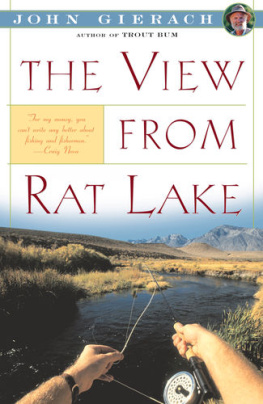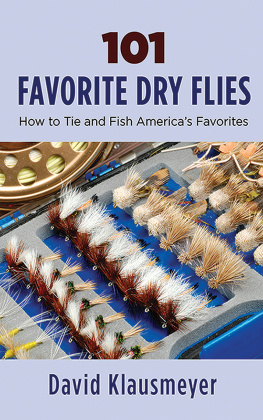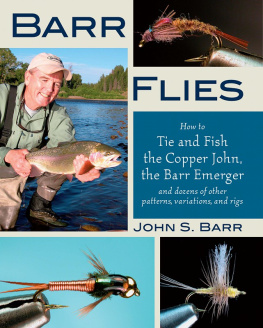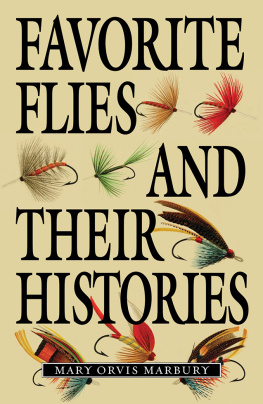John Gierach - Good Flies: Favorite Trout Patterns and How They Got That Way
Here you can read online John Gierach - Good Flies: Favorite Trout Patterns and How They Got That Way full text of the book (entire story) in english for free. Download pdf and epub, get meaning, cover and reviews about this ebook. year: 2014, publisher: Lyons Press, genre: Art. Description of the work, (preface) as well as reviews are available. Best literature library LitArk.com created for fans of good reading and offers a wide selection of genres:
Romance novel
Science fiction
Adventure
Detective
Science
History
Home and family
Prose
Art
Politics
Computer
Non-fiction
Religion
Business
Children
Humor
Choose a favorite category and find really read worthwhile books. Enjoy immersion in the world of imagination, feel the emotions of the characters or learn something new for yourself, make an fascinating discovery.

- Book:Good Flies: Favorite Trout Patterns and How They Got That Way
- Author:
- Publisher:Lyons Press
- Genre:
- Year:2014
- Rating:3 / 5
- Favourites:Add to favourites
- Your mark:
- 60
- 1
- 2
- 3
- 4
- 5
Good Flies: Favorite Trout Patterns and How They Got That Way: summary, description and annotation
We offer to read an annotation, description, summary or preface (depends on what the author of the book "Good Flies: Favorite Trout Patterns and How They Got That Way" wrote himself). If you haven't found the necessary information about the book — write in the comments, we will try to find it.
The favorite fly patterns of one of the countrys top angling writers, revised and updated.
Good Flies: Favorite Trout Patterns and How They Got That Way — read online for free the complete book (whole text) full work
Below is the text of the book, divided by pages. System saving the place of the last page read, allows you to conveniently read the book "Good Flies: Favorite Trout Patterns and How They Got That Way" online for free, without having to search again every time where you left off. Put a bookmark, and you can go to the page where you finished reading at any time.
Font size:
Interval:
Bookmark:
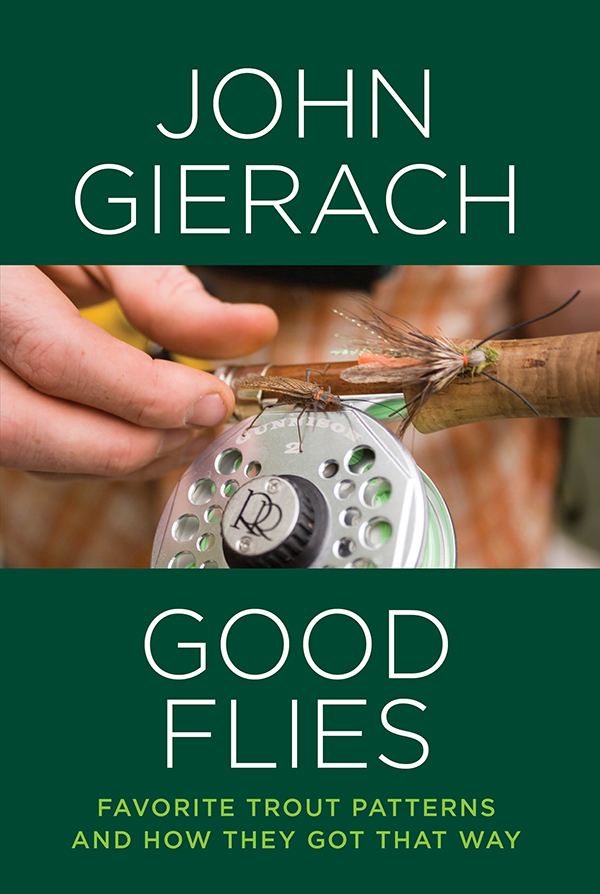
Good Flies
Books by John Gierach
All Fishermen Are Liars
No Shortage of Good Days
Fools Paradise
Still Life with Brook Trout
At the Grave of the Unknown Fisherman
Death, Taxes, and Leaky Waders: A John Gierach Fly-Fishing Treasury
Standing in a River Waving a Stick
Fishing Bamboo
Another Lousy Day in Paradise
Dances With Trout
Even Brook Trout Get The Blues
Where the Trout Are All As Long As Your Leg
Sex, Death and Fly-Fishing
The View from Rat Lake
Fly Fishing Small Streams
Trout Bum
Fly-fishing the High Country
Good Flies
Favorite Trout Patterns and How They Got That Way
John Gierach
Illustrations by Barry Glickman
except where noted
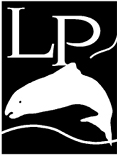
LYONS PRESS
Guilford, Connecticut
Helena, Montana
An imprint of Rowman & Littlefield
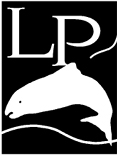
LYONS PRESS
An imprint of Rowman & Littlefield
Distributed by NATIONAL BOOK NETWORK
Text copyright 2000, 2014 by John Gierach
Illustrations by Barry Glickman except where noted
All rights reserved. No part of this book may be reproduced or transmitted in any form by any means, electronic or mechanical, including photocopying and recording, or by any information storage and retrieval system, except as may be expressly permitted in writing from the publisher.
British Library Cataloguing-in-Publication Information available
Library of Congress Cataloging-in-Publication Data available
ISBN 978-1-4930-0744-8 (hardcover)
eISBN 978-1-4930-1556-6 (eBook)
 The paper used in this publication meets the minimum requirements of American National Standard for Information SciencesPermanence of Paper for Printed Library Materials, ANSI/NISO Z39.48-1992.
The paper used in this publication meets the minimum requirements of American National Standard for Information SciencesPermanence of Paper for Printed Library Materials, ANSI/NISO Z39.48-1992.
Contents
ACKNOWLEDGMENTS
T hanks to my fly-tying friends: Ed Engle, Chris Schrantz, Roy Palm, Mike Price, and Vince Zounek, among others, for help, encouragement, and mostly for the good, idle conversation that leads to book ideas. Thanks, also, to Mike Clark and, again, Vince Zounek, for letting me paw through their libraries; and thanks for all of the above and more to A.K. Best, my friend and teacher.
INTRODUCTION TO THE NEW EDITION
G ood Flies seems more regional and eccentric than it did when I published it fourteen years ago. I now see it as another in a long line of books by fishermen extolling their favorite fly patterns, seasoned with random thoughts about fish, fishing, and whatever else comes to mind. These books are as different as the people who wrote them, but they all follow the same rough outline and all seem to have been written partly to get something off the authors chest and partly in a genuine attempt to be helpful. After all, when youve spent years thinking about fly patterns, tinkering at the vise, and occasionally catching a trout, you begin to think your ideas could be useful to others.
These books come in all shapes and sizes. Some, like Selective Trout by Doug Swisher and Carl Richards (1971), and before that Matching the Hatch by Ernest Schwiebert (1955), were big, landmark books that codified a way of thinking about fly patterns and became part of the fly-fishing culture. Fishermen still talk about trout being selective or about having to match the hatch, even though theyve never read the books.
Others, like Iwamasa Flies by Ken Iwamasa and A.K.s Fly Box by A.K. Best, as well as dozens of other books, are quirkier, more local, and more idiosyncratic: basically peeks inside the fly boxes of good, thoughtful fishermen, for what its worth.
And sometimes its worth a lot. Most of the flies in Ken Iwamasas book were recognizable, but he also introduced some patterns that were unlike anything wed seen before, like the Tarcher Nymph and especially the Iwamasa Duns. I think those duns came out of some of the first original thinking in fly tying in a generation. They were stunningly realistic in a spare, impressionistic sort of way and, once you got the hang of it, they were easy enough to tie with inexpensive and easy-to-find materials. You could say the patterns owed debts to the No-Hackle duns for their uncluttered silhouettes and to the Comparaduns for the placement of deer-hair tips as legs, but thats just an acknowledgement that fly patterns dont arise in a vacuum and it would be just as accurate to say they were completely original.
The Iwamasa Duns were specialized patterns for picky trout in slow currents, and Im surprised they didnt catch on better than they did, although some fishermen who like technical spring creeks and tailwaters still tie and carry them as secret weapons.
A.K. Best is a different kind of tier: a traditionalist whose innovations are so subtle you may not even notice them right away. At first glance his flies just look like theyd work, but then it begins to sink in that, although theyre very much like the traditional patterns youve been seeing for years, theyre trimmer and perkier than most, with just noticeably thinner bodies, taller wings, and longer tails cocked at a slight upward angle.
And there are the colors that more closely match those of natural insects than any flies Ive seen. A.K. dyes most of the materials himself using his own painstakingly worked-out recipes. He dyes dry-fly necks, wingers, quills, and biots and his dubbing is blended from a combination of colors using precise, reproducible formulas for accuracy and consistency. (That is, he gets his Blue-Winged Olive dubbing by blending 3 parts white, 1/2 part yellow, 1 part ginger, 1 part olive, and 1/2 part gray rabbit fur because, he says, There are no solid colors in nature.) So many tiers asked him how he did it that he finally published a book on the subject, Dyeing and Bleaching Natural Fly-Tying Materials .
A.K. is also the fastest tier Ive ever seen. At the height of his production, with a mortgage and daughters in college, he turned out three thousand dozen flies a year while working full time in a fly shop and still finding time to go fishing. That gave him a perspective on the relationship between craftsmanship and practicality that most of us lack.
Ive been tying flies for my own use for a little over forty years nowwith a couple of mostly ill-fated detours into professional tying early on when I was short of cashand Ive spent most of that time trying to mimic the styles of other tiers and appropriate their patterns for my own use.
Thats most of the time, but not all. After reading Vince Marinaros A Modern Dry-Fly Code , another quirky, regional book that introduced the Thorax Dun, I thought I should invent something myself, but I never did. Everything I came up with had either been done before (and better) or it turned out to be unworkable. Its not that there were no new ideas left; its just that others always had them before I did.
I also had the usual flirtation with burned wings, extended bodies, and so on (or what Dave Whitlock once called eyeballs, elbows, and arseholes). I managed to make some nice-looking flies, but they were time-consuming to tie and didnt work any better than flies that were quicker and easier to make. I finally came to agree with most of the fishermen I know that flies werent individual works of art, but expendable ammunition.
Font size:
Interval:
Bookmark:
Similar books «Good Flies: Favorite Trout Patterns and How They Got That Way»
Look at similar books to Good Flies: Favorite Trout Patterns and How They Got That Way. We have selected literature similar in name and meaning in the hope of providing readers with more options to find new, interesting, not yet read works.
Discussion, reviews of the book Good Flies: Favorite Trout Patterns and How They Got That Way and just readers' own opinions. Leave your comments, write what you think about the work, its meaning or the main characters. Specify what exactly you liked and what you didn't like, and why you think so.


